The image of Walden Pond, a serene place of imaginable beauty with a small cabin close to its shore, is somehow etched in most of our minds. Few of us have actually been there or even seen a picture of the actual place. Still Walden Pond has enduring symbolic value that finds its home deep in our personal psyche and our collective soul. We may have recalled hearing about Walden Pond as part of our early education, but few can remember much about what they might have heard or read, and yet the image of the pond in our mind’s eye lingers and may even come into a clearer view with each passing year.

Artist’s Sketch of Thoreau’s Cabin included on the title page of the original book, Walden or Life in the Woods, published in 1854.
This is all consistent with Henry David Thoreau’s vision for the pond. Although for Thoreau, Walden Pond was definitely a physical place, Walden was also a metaphor for an internal journey of self discovery and this metaphor has now been internalized in the hearts and minds of countless individuals. Ultimately Walden straddles two worlds that are in reality a unity The first world is an accurate, literal, and often highly detailed description of Thoreau’s two year stay at Walden Pond. The second is a world of metaphor and symbols that allows us to internalize our own vision of Walden Pond as we travel with Thoreau on his internal journey of self-discovery that points to a transcendent world of soul and spirit. In both the reader participates in this unity, making it a shared experience of transcendence.
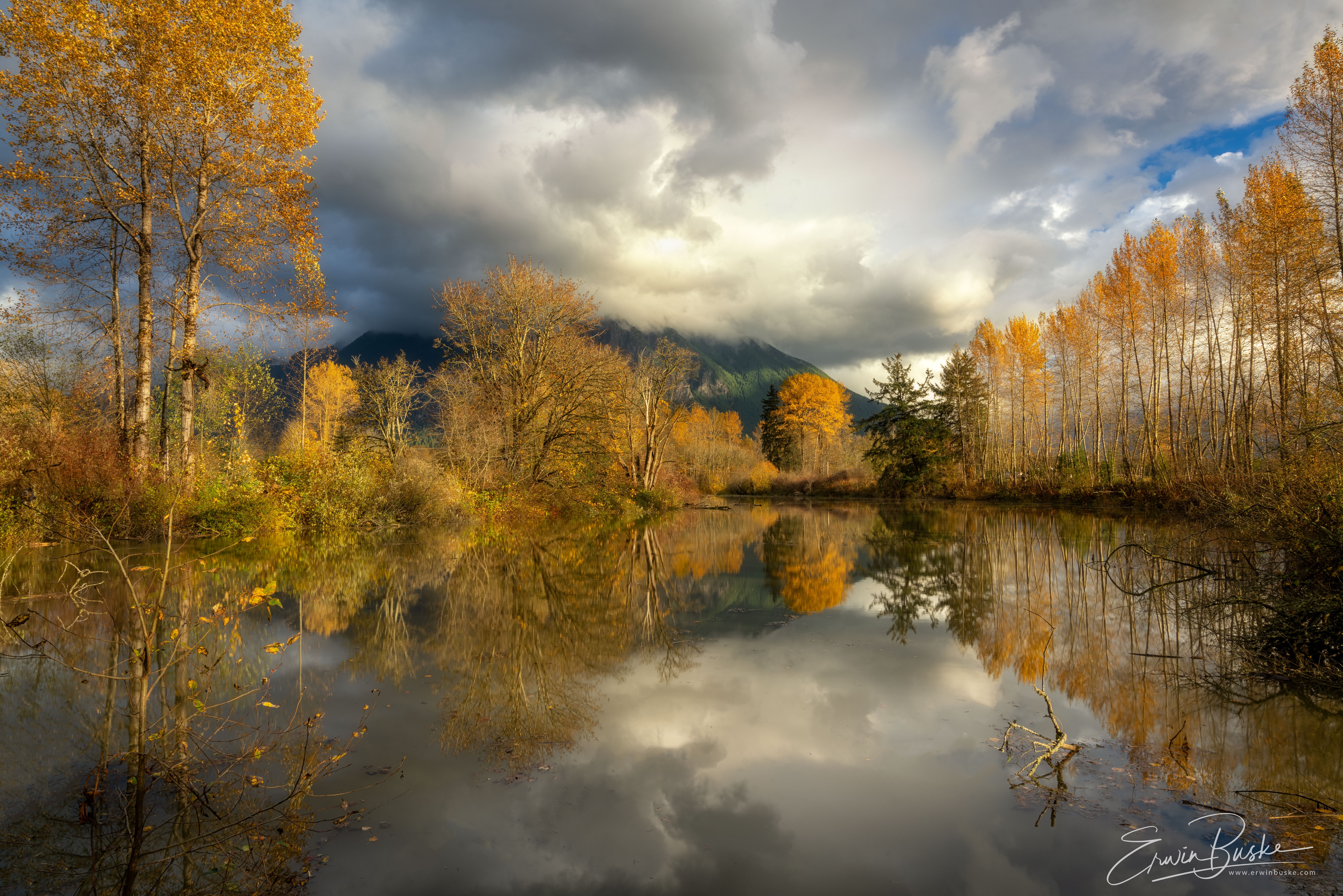
Walden Pond Revisited
The journey to Walden pond for each person will be different, but all of us will share in a common vision of transcendence. This pond for me is my Walden Pond close to where I live in Washington State USA. I believe for me that it evokes some of the same mood of the transcendent that Thoreau felt at the shore of the actual Walden Pond in Concord, Massachusetts.
My personal encounter with Thoreau began in in my sophomore year of high school. As part of our reading assignment of Walden, the class walked over to a close by wooded area. Each of us was instructed to find our somewhat isolated area in the forest and then to just sit quiet, letting go as much as possible of any preexisting thoughts. With paper and pencil in hand and using all five of our senses, we were then to record in as much detail as possible our observations, thoughts, and emotions-what ever came to consciousness in our newly found forest home. This modest assignment is of course what Thoreau did on a much larger scale at Walden Pond. He left behind what he saw as the corrosive effects of society and moved to a small cabin in the woods close to Walden Pond. His objective:
“I went to the woods because I wished to lived deliberately, to front only the essential facts of life, and see if I could not learn what it had to teach, and not when I came to die discover that I had not lived.”

Young Tree in the Forest
I thank my High School teacher for encouraging me to go into the woods for this meditative experience. It helped sow the seeds for my almost life-long series of meditative journey’s, some small, others large, into the wonders and beauties of nature. This meditative experience has also been part of my photographic experience since day one. But like most of us, I have had many detours along the way of my journey into nature-impossible work schedules, striving for material success, and periods of time where my day to day activities and relationships with others did little to help nurture my soul and spirit. For a short period of time I attended a New Thought church based upon some of the ideas of Emerson, Thoreau and the Transcendentalists. But I found New Thought lacking in one very important area–nature. Although New Thought placed a healthy emphasis on changing our minds to change our lives for the better, there was little or no emphasis on celebrating ones connection to nature that was so important in Emerson’s and especially Thoreau’s thought. Getting married to my loving and supportive wife Julia, raising our daughter Caroline, and a renewed focus on nature and photography has done much to rekindle my spirit in the last two decades. I am forever grateful to Julia, Caroline and living as close as possible to nature for helping reshape my life, making manifest sources of inspiration to nurture and steadily evolve who I am as a person–my authentic self, my love for nature and ultimately the art and craft of my photography.

Forest Carpet of Clouds
A couple of years ago I started reading and rereading Thoreau’s Walden again, It is amazing how a book can take on new life and energy several decades later. His message contained in the chapters of Walden Pond seemed to speak to me like never before, helping me to better communicate thoughts and impressions that have been going on in my mind for some time. In this blog post I will discuss my twelve takeaways from my recent reading and rereading of Walden Pond, offer some probing questions for everyone to consider, along with some questions more directed at nature photographers. This article, however, is intended for a wide audience of people, both photographers and non-photographers alike. We all need the “tonic of nature”!
Before launching off on my takeaways I will lay some groundwork with a discussion of the following: (1) A very brief biography of Thoreau, (2) Thoreau and Transcendentalism, (3) and Walden Pond-a physical and spiritual place.
Henry David Thoreau a Brief Biography
Henry David Thoreau, (1817-1862) was born in Concord, Massachusetts, which was center of his life. Thoreau studied at at Harvard University, graduating in 1837. While still in college, in 1835 he contracted tuberculosis and suffered from recurring bouts throughout his life. He made his living by working in the pencil factory, by doing surveying, by lecturing and teaching, and by publishing essays in newspapers and journals. His income acquired primarily through side gigs, however, was always very modest, and his main concerns were his daily afternoon walks in the Concord woods, the keeping of a private journal of his nature observations and ideas, and the writing and revision of essays for publication. Thoreau did not identify himself with any of his lines of work and described his occupation this way “My profession is always to be on the alert to find God in Nature, to know his lurking-places, to attend all the oratorios, the operas, of nature.”
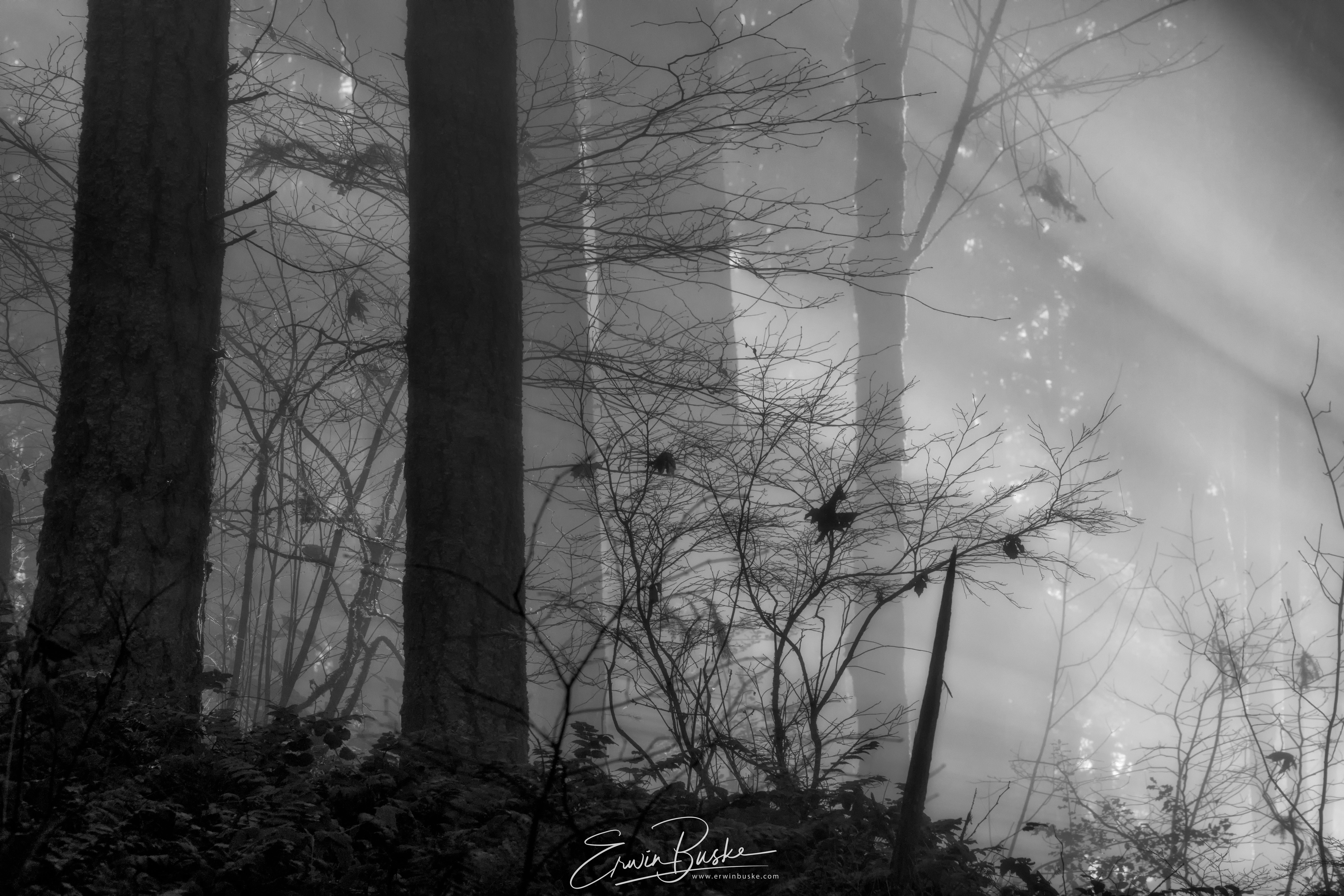
A Walk in the Forest
A decisive turning point in Thoreau’s life came when he met Ralph Waldo Emerson at Harvard. The older Emerson introduced Thoreau to transcendentalism and encouraged him to start recording his experiences in a journal. Thoreau was a member of the Emerson household from 1841 to 1843, earning his living as a handyman. In 1843 he was a tutor to William Emerson’s sons in Staten Island, New York, and in 1847-48 he again lived in Emerson’s house.

IMAGE: 37 year-old Henry Thoreau by Samuel Worcester Rowse, as he appeared in the Summer of 1854 when “Walden” was published.
Thoreau who wrote “In wildness is preservation of the world” is often credited with being the father of the American Conservation Movement, not so much because of political advocacy but because he established that nature is essential for society to thrive and for an individual’s own spiritual growth. Thoreau is also widely known as a nature writer and Walden is often refereed to as the urtext, the place where all American nature writing starts. In addition to being a champion of nature, Thoreau is also known for his views on civil disobedience, mainly the need to prioritize one’s conscience over the dictates of laws. Both Gandhi and Martin Luther King referred back to Thoreau to help explain their own acts of civil disobedience associated with the Indian Independence and Civil Rights movements respectively. Thoreau himself was an outspoken abolitionist, serving as a conductor on the underground railroad to help escaped slaves make their way to Canada. He wrote strongly-worded attacks on the Fugitive Slave Law (“Slavery in Massachusetts”) and on the execution of John Brown.
In May 1862, Thoreau died of the tuberculosis with which he had been periodically plagued since his college years . Thoreau’s best friend Emerson wrote and provided his eulogy (exerts):
“He was bred to no profession; he never married; he lived alone; he never went to church; he never voted; he refused to pay tax to the State; he ate no flesh, he drank no wine, he never knew the use of tobacco; and, though a naturalist, he used neither trap nor gun. He chose, wisely no doubt for himself, to be the bachelor of thought and Nature….The country knows not yet, or in the least part, how great a son it has lost. … His soul was made for the noblest society; he had in a short life exhausted the capabilities of this world; wherever there is knowledge, wherever there is virtue, wherever there is beauty, he will find a home.”
Thoreau and Transcendentalism
The the principal ideas of the American Enlightenment, the celebration of pure reason and the belief that science (at least how it was understood at the time) has an answer for just about everything, played a key role in the development of the American Republic from its founding until the early part of the Nineteenth Century. The elevation of reason also played a roll even in the practice of religion and this caused many transcendentalists to abandon the Unitarian Church because they perceived the denomination had an overly reasoned approach to explaining mysteries that defy rational explanation. Toward the mid nineteenth century we see a counter movement in American culture and life based upon a Romantic notion more centered on intuition, emotion, and direct experience of nature as necessary conditions for developing an appreciation of the sublime and mysteries of life. We see this in American Art as artists progressed from primarily documentary portraiture to romanticized interpretations of the American Landscape. We see this also in the literary world with the writings of Emerson, Thoreau, Muir and others.

Sunset in the Rockies by Albert Bierstadt
Emerson attributed the philosophical underpinnings of Transcendentalism to the Idealism of German Philosopher Emanuel Kant as explained in Kant’s book titled the Critique of Pure Reason. Kant divided the world into its two aspects: the phenomenal world and the noumenal world. The phenomenal world is the material world we are aware of; this is the world we construct out of the sensations that are present to our consciousness. But if we limit our understanding of the world to appearances only, in other words what we can perceive empirically through our senses, our perception of the world is not complete and may actually be a kind of an illusion, and certainly not what Kant refers to as “the thing in itself”. The noumenal world consists of things we seem compelled to believe in, but which we can never know empirically because we lack sense-evidence of it. Kant also called this noumenal world “the thing in itself”, something that is beyond space and time.
Thoreau as a transcendentalist never denied the validity of the material world, but he also did not see the material world as compete. Both Emerson and Thoreau embraced the scientific method of empirical inquiry as it was understood at the time. This is especially apparent in Thoreau’s work as a naturalist, documenting and categorizing plants. But Thoreau’s inquiry as a naturalist was not limited to the material world, to what can be objectively perceived through the senses.. The path of self awareness transported him beyond the material world and through the embrace of wild nature took him to a noumenal world of soul, spirit and the divine.
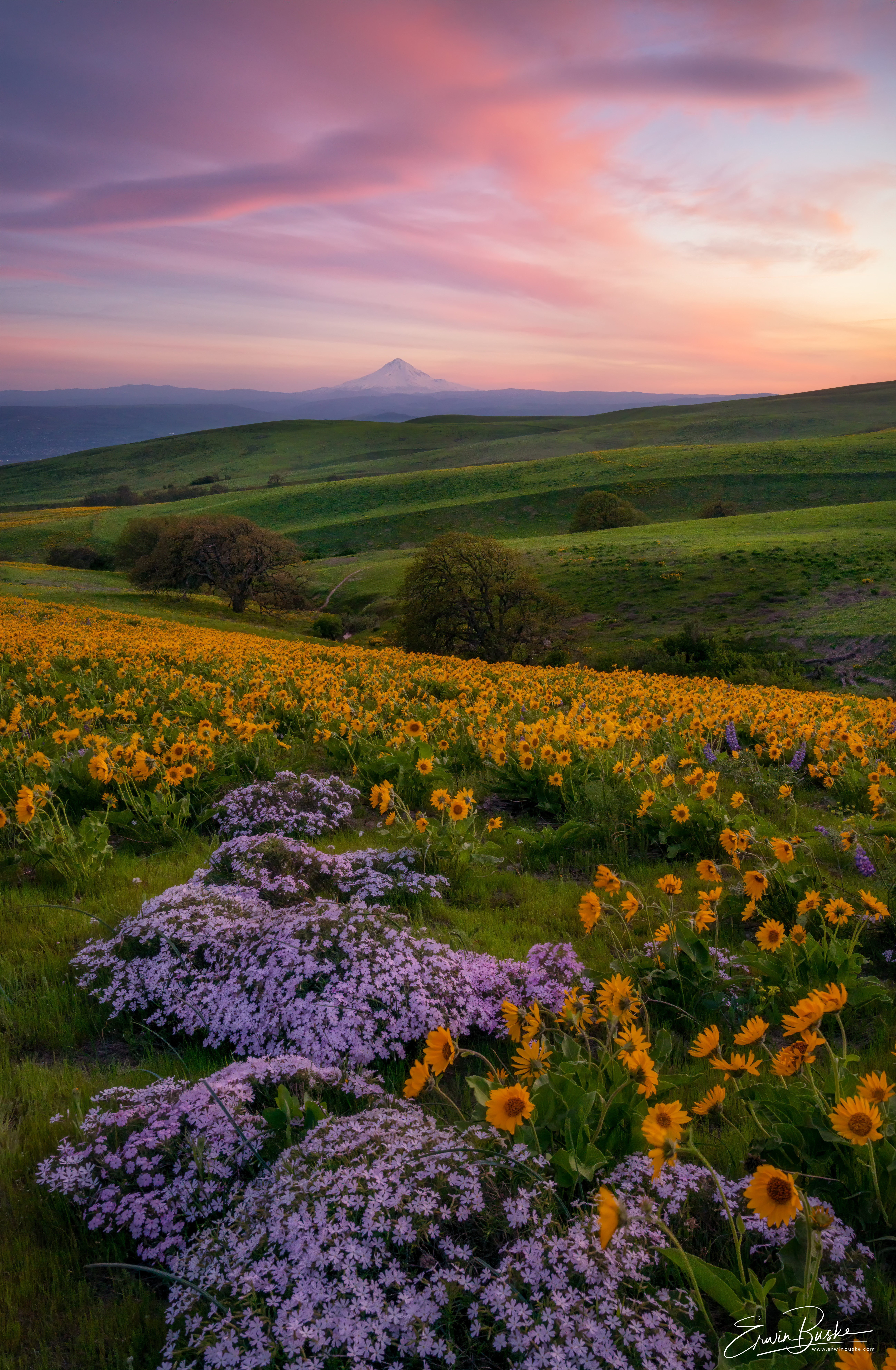
Phlox and Sun Flowers in Paradise–Columbia River Gorge
Nature often has the ability to lure us deep into a rapidly unfolding scene, but at the same to elevate us to a place that seems beyond the temporal. For more on Transcendental Nature see my blog post Transcendental Nature Photography: Creating Inspiring Images with Lasting Impact.
In Walden, Thoreau provides to us his personal story of how in nature he reconnected with his own soul and its inherent divinity, thus fulfilling the potential for an ideal existence in the real world. In doing this Thoreau takes us beyond theory of Kant and Emerson’s often abstract ramblings, and provides us a very accessible example of what our own transcendental journey might look like.
Walden Pond
Upon first reading Walden’s pond one may initially get the impression that Thoreau is merely providing a meticulously detailed documentary account of his experience living there for two years. But as the book progresses it is clear that Walden Pond is more than that and is full of symbolism and metaphors for the awakening of the soul and spiritual growth. This is clear in passages such as this one from the chapter titled, The Ponds, where Thoreau describes the water of Walden Pond like this “It is the earth’s eye, looking into which the beholder measures the depth of his own nature.” It is also evident with this passage also from the chapter the Ponds:
“Though the woodchoppers have laid bare first this shore and then that, and the Irish have built their sites by it, and the railroad has infringed on its water which my youthful eyes fell on; all the changes is in me. It has not acquired one permanent wrinkle after all its ripples. It is perennially young.”
What I find remarkable from the above passage is that even in Thoreau’s own lifetime he witnessed the encroachment of civilization at Walden Pond, with a railroad visible from the pond, residences popping up , and the falling of most of the large trees. But even in the midst of these physical changes, Thoreau thought that the essence of the pond had not changed, and in a sense seemed to be outside of space and time. Thoreau suggests here that the spiritual aspect of Walden Pond transcends this material world and even his own perception. It is the same pond where Thoreau discovers the depth of his own nature, that is his spiritual self. Ultimately Walden is both, part of this material world that is constantly changing and something eternal, beyond the material world and even sensory perception. It is the genius of Thoreau that throughout Walden Pond he is able to closely, inseparably, and artistically link real and ideal worlds. In this regard he far exceeds even his mentor Emerson and in my opinion anyone who has since appeared on the literary stage.
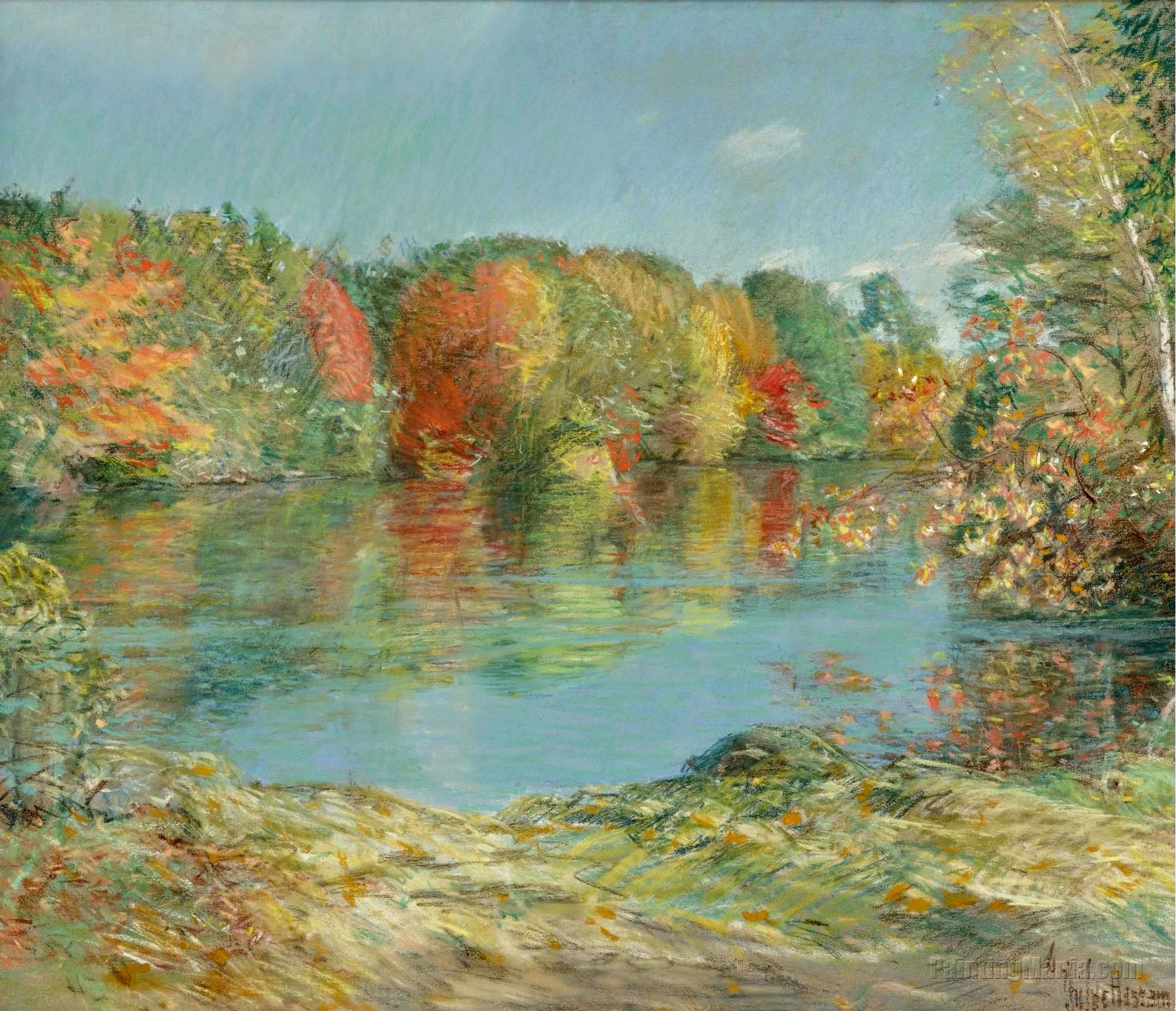
Artist depiction of Walden Bond, Frederick Chide Hassan
In the Chapter titled Ponds Thoreau does provide as near to a concise summary description of Walden Pond as can be found in the book:
” The scenery of Walden is on a humble scale, and, though very beautiful, does not approach to grandeur, nor can it much concern one who has not long frequented it or lived by its shore; yet this pond is so remarkable for its depth and purity as to merit a particular description. It is a clear and deep green well, a half a mile long and a mile and three quarters` in circumference, and contains about sixty one and a half acres, a perennial spring in the midst of pine and oak woods, without any visible inlet or outlet except by the clouds and evaporation.”

Cedar River Grove–This is a somewhat ordinary place along side a noisy suburban road that was completely transformed by natures gift of some special mid-morning light.
By Thoreau’s own admission, Walden was a place of understated beauty and not what we would now refer to as iconic or epic beauty. It was very humble in its origin. Many people are surprised to hear that Walden was only a couple of miles away from Concord Massachusetts. This was not a remote spot even by the standards of the Nineteenth century. But to Thoreau Walden was extraordinary in a couple of ways, its depth and purity. Thoreau mentions that the shoreline drops so suddenly that one could take one step into the water and already loose touch with the ground and that no none knew for sure the absolute depth of the pond. The water is so pure that in the right light ones ability to see into the water appears almost unlimited. Depth and purity of course are coincidentally qualities we normally associate with the spiritual world. The Walden Thoreau has introduced us to, however, could be just about anywhere, even in our own backyards, and it is in that context I will now discuss my key takeaways from reading and rereading several times the book.
(1) Access to Nature is our Birthright
“Our village life would stagnate if it were not for the unexplored forests and meadows which surround it. We need the tonic of wildness…At the same time that we are earnest to explore and learn all things, we require that all things be mysterious and unexplorable, that land and sea be indefinitely wild, unsurveyed and unfathomed by us because unfathomable. We can never have enough nature.” Thoreau Walden Chapter 17 Spring
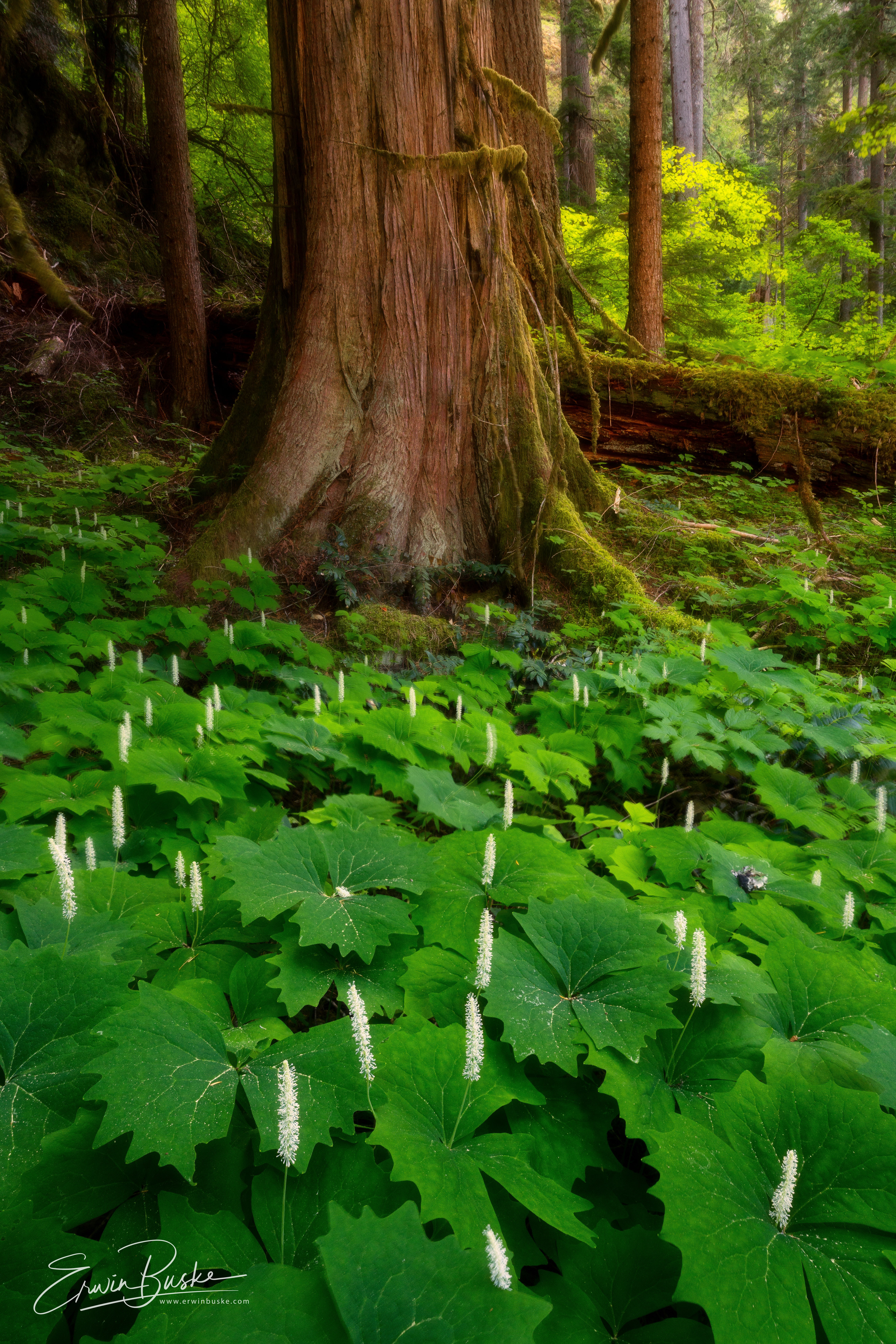
This quotation comes in the closing chapter of Walden titled Spring. With Spring Thoreau experiences a kind of rebirth of his soul. Awakening from the depths of winter, Thoreau experiences an elevation of his spirit in his experience of the wonders and mysteries of nature. With this awakening Thoreau recognizes the importance of nature for all of humanity. Even as science finds explanations for much of what we can observe and study through our senses, there is a part of nature that will always remain mysterious and unfathomable. The path to self discovery and spiritual growth for everyone goes right through Nature in all of her mysteries. This is also a major humane reason why it is so important to protect and nurture nature. If we do not have access to nature or due to our recklessness we cause the destruction of nature, we are in effect cutting our selves off from the source of our spiritual development. Ultimately “In Wildness is the Preservation of the World” Thoreau Walking.
Drawing inspiration from Thoreau and others, I am a big champion of having wild places close to cities and suburban places. I wrote about one such place in Waterfalls of Cougar Mountain. Are there wild or semi wild places close to where you live? How often do you visit these places? For photographers, does your photography practice include frequent visits to nearby places where you can stay in touch with the pulse of nature on a near daily basis?
(2) What we need is a Breath of Fresh Air
” So thoroughly and sincerely are we compelled to live, reverencing our life and denying the possibility of change. This is the only way, we say: but there are as many ways as there can be drawn radii from the center. All change is a miracle to contemplate; but it is a miracle which it taking place every instant. Walden Chapter One Economy”

Olympics Sunset: Come Fly Away
With Thoreau’s decision to live at Walden’s Pond, we see a pattern that was also part of the journey of two other Transcendentalists. The first is Thoreau’s teacher and mentor Ralph Waldo Emerson, and the second is the legendary conservationist John Muir. All three of these individuals put different levels of emphasis on Nature as the source of renewal, with Emerson’s Nature being often being more abstract, Thoreau’s more internalized, and Muir’s a kind of mountaintop spirituality involving what are now iconic landscapes. Nevertheless, a major change that brings each of these men into a new and fresh contact with nature plays a key role in their journey of self discovery. What we also see in all three of these individuals is a pivotal point in their lives when they leave an old world behind to embrace a new world where the vestiges and shackles of their old world can be discarded and left behind.

Many scholars are reluctant to count John Muir as a Transcendentalist, but any in depth reading of Muir by those familiar with Thoreau and Emerson will see a close affinity of perspective and thought between these individuals. Muir was a student of both Thoreau and Emerson and actually met Emerson for several days in Yosemite in 1871. According to the Sierra Club which Muir founded, “Muir’s copy of the twenty-volume, 1906 edition of The Writings of Henry David Thoreau is heavily annotated, underscored, and indexed on the blank pages with extensive commentary by Muir”. Muir’s interpretation of the religious spirit of nature is remarkably similar to the thoughts of Emerson and Thoreau as is evident in this passage and others. ““When one tugs at a single thing in nature, he finds it attached to the rest of the world.” In June 1893, John Muir visited Sleepy Hollow Cemetery in Concord and laid flowers on Thoreau’s and Emerson’s graves. ”
With the untimely death from tuberculosis of Emerson’s first wife Ellen at the age of only nineteen, Emerson leaves the ministry and sets sail for Europe where he meets the romantic poets Coleridge and Wordsworth. Emerson’s life is forever changed as he leaves behind established religion, and it is at this time that his new transcendentalist vision for salvation through direct experience of nature begins to take hold. Later we also see something similar with Muir. At age 29 Muir was blinded in a factory accident. Although his sight eventually came back, this was a tipping point in his life. He left everything in his life behind, his job as an efficiency expert in the factory, his connection to the Church and his family, and embarked on a 1,000 mile march to immerse himself in nature, starting in Indiana and ending in Florida where he caught malaria. This experience was the impetus to send him out west to California where he found mountaintop spirituality and set in motion his life long effort to conserve and protect the natural world. Thoreau’s journey to Walden Pond, just two miles away from Emerson’s home in Concord, Massachusetts may not seem quite as grand, but this journey also represented his turning away from a society that in the face of rapid industrialization was causing people to live a lives of “quiet desperation”. For Thoreau, the true frontier was not thousands of miles away across the sea or land, but within his own consciousness as he immersed himself in the natural wonders of Walden Pond.
Is there a time period in your own life where you broke away from much of your past and turned your attention to new images and a dream of a new future? For photographers, has a major life change been part of your photographic journey and does this change still provide to you sources of inspiration? Sources of Inspiration for Nature and Landscape Photography: Finding Your Photographic Vision
(3) Voluntary Simplicity
“Our life is frittered away by detail. Simplify, Simplify.” Walden
Thoreau lets us know his original intention for coming to Walden Pond in the second chapter of his book title of his book “Where I Lived, and What I Lived For “
“I went to the woods because I wished to live deliberately, to front only the essential facts of life, and see if I could not learn what it had to teach, and not, when I came to die, discover that I had not lived.”

Window through an Old Growth Cedar Forest
This quote comes after the first chapter of the book titled Economy where Thoreau provides an elaborate explanation of how he was able to move close to the pond, build a small cabin, and largely become self sufficient with a small surplus that he could barter or turn into a small amount of money. Adopting this kind of lifestyle for him was necessary to remove himself from what he saw as the unnecessary distractions of living life in a society that that does not nurture the development of ones soul. These distractions also included not only employment in what was then fast becoming an industrial society, but also the processions that often serve to complicate our life, weigh us down, making it difficult to follow or even hear the still quiet voice within. Ultimately he wished to stand on its head the prevailing work ethic at the time of working six days and resting on the Sabbath, a goal which he successfully accomplished at Walden Pond.
Most of us realize at some point along our journey that the world we have constructed around our self, including such things as expensive homes, cars, well paying but demanding jobs, and even some of our complicated relationships with others-are adding unnecessary complexity to our life and standing in the way of living a more fulfilling life consistent with our true calling. Unraveling this complexity and moving toward a simplified life seems like a daunting task to most and for some maybe not even an option. But living a more simple life will be necessary to create the time and space to move toward a life closer to nature and getting in touch with who we truly are as a person, our authentic self.
Have you ever felt the need to simplify your life, and if so what steps have you taken to accomplish this? For photographers, do you ever feel the life you have built around yourself including your occupation, even if nature photography, limits your access to sources of inspiration, including nature itself?
(4) Daily Practice
A good part of the book Walden is dedicated to writing about Thoreau’s daily spiritual practice. This practice consisted of the following: (A) contemplation, (B) journaling, (C) walking, (D) conversations, and (E) reading. All of these practices helped Thoreau establish a daily rhythm that helped him in the process of walking up to his true nature. This process of waking up was not as much about finding meaning as it was about awareness and feeling fully live in the present moment.
Thoreau would spend hours in front of his cabin and along the shore of Walden Pond engaged in quiet contemplation. In doing this Thoreau was not so much seeking seeking answers, but letting nature reveal itself and speak to Thoreau on its own terms. Thoreau also kept a daily journal for most of his life and these journal entries helped him describe what he was observing not just in a matter of fact way, but also in a more lyrical and evocative way. Moving more toward a poetic description was necessary for those aspects of his observations which eluded a more precise description. For example Thoreau would often feel a surging energy in nature, an experience better suited to poetry than his more scientific descriptions of nature. Walks were a regular part of his routine and these walks were meditative in nature with Thoreau immersing himself and being present in nature that surrounded him.

Foggy Trail-One of the many trails I have close by access to for walking on a daily basis.
Although Thoreau lived a somewhat solitary existence at Walden, portions of the book are dedicated to discussing his conversations with visitors. In Walden Thoreau states: “I had three chairs in my house, one for solitude, two for friendship, three for society.” In the chapter visitors, Thoreau introduces his admiration for a wood cutter who would occasionally drop by for conversation. The wood cutter seemed to be living in harmony in nature, but lacked any kind of intellectual or spiritual awareness. This helped Thoreau realize that he must go deeper in his own spiritual practice, recognizing that it is not sufficient to just be working in nature such as in his own practice of farming, but that a deeper immersion involving deep thought and the mind is necessary. It is noted in his second year at Walden Pond Thoreau cut way back on his cultivation of his fields to open up more time for him to spend experiencing nature without the distraction of work and toil.
Just like many of us take our favorite book on wilderness adventures (often Walden itself!), Thoreau was an also avid reader during his quiet hours at Walden Pond. At Walden Thoreau mentions multiple times his reading of ancient Hindu texts including the Bhagavad Gita and the Vedas. All of these texts came from Mr. Emerson’s library and Thoreau read them without any interpretive assistance finding in them what Aldous Huxley famously termed the “Perennial Philosophy”, common themes that ring true in wide variety of ancient texts and cultural traditions. To get a sense of the extent to which these texts captured his imagination consider this passage from Walden:
“I lay down the book and go to my well for water, and lo! there I meet the servant of the Bramin, priest of Brahma and Vishnu and Indra, who still sits in his temple on the Ganges reading the Vedas, or dwells at the root of a tree with his crust and water jug. I meet his servant come to draw water for his master, and our buckets as it were grate together in the same well”.
Thoreau wrote to his friend Harrison Blake in 1849: “To some extent, and at rare intervals, even I am a yogi!” One actually finds in Walden a beautiful story of one man’s realization of Ātman which is a Sanskrit word that means inner self or soul. In Hindu Philosophy, Ātman is the first principle, the true self of an individual beyond identification with phenomena, the essence of an individual, somewhat similar to the previously mentioned numinal world of the nineteenth century German Philosopher, Emanuel Kant. What goes around comes around! Thoreau’s genius is that in the creation of Walden he shared his story that made much more accessible to others this idea of moving beyond ego and the material world to self realization.
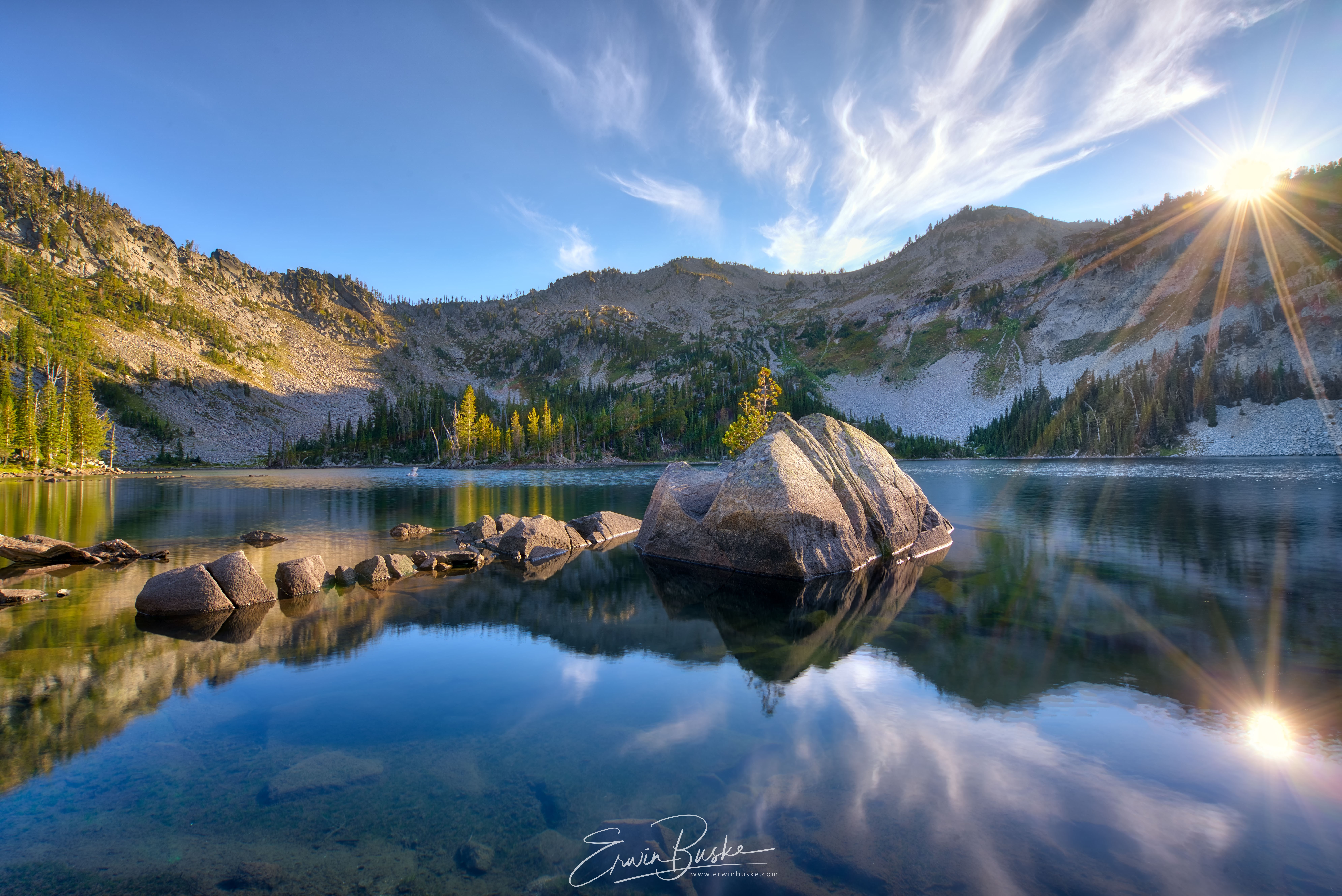
Self Realization–Eagle Cap Wilderness Area
I have found in my own life there is nothing like a regular practice focused on nature to keep life in perspective and focus on what truly is important. My practice includes all of the practices that Thoreau discusses in Walden, but I am sure I am not nearly as devoted to these practices as the master Thoreau! These practices have also formed the groundwork for my creative pursuits especially photography. Does your current life include time for daily spiritual practices, especially time in nature? For photographers, do you often spend time in nature, without camera, just observing, listening, and absorbing what nature has to offer?
(5) Follow the Beat of Your Own Drummer
“If a man does not keep pace with his companions, perhaps it is because he hears a different drummer. Let him step to the music which he hears, however measured or far away.” Walden Conclusion
Thoreau like Emerson and all Transcendentalists puts much emphasis on the need for individualism. But in this passage Thoreau adds his own perspective. If one is not keeping up their peers in what are often competitive pursuits, it may not be because one lacks the ability to keep up, but rather one is drawn to another calling. In other words, the feeling of the need to compete in certain endeavors—for example for jobs that convey a sense of status and for bigger and better homes — may actually be taking us further away from our true calling and who we are as a person. It is following a script set by society that has largely lost its connection to nature. Thoreau points to another way that shuns conformity and this way involves moving closer to rhythms and pulse of nature.
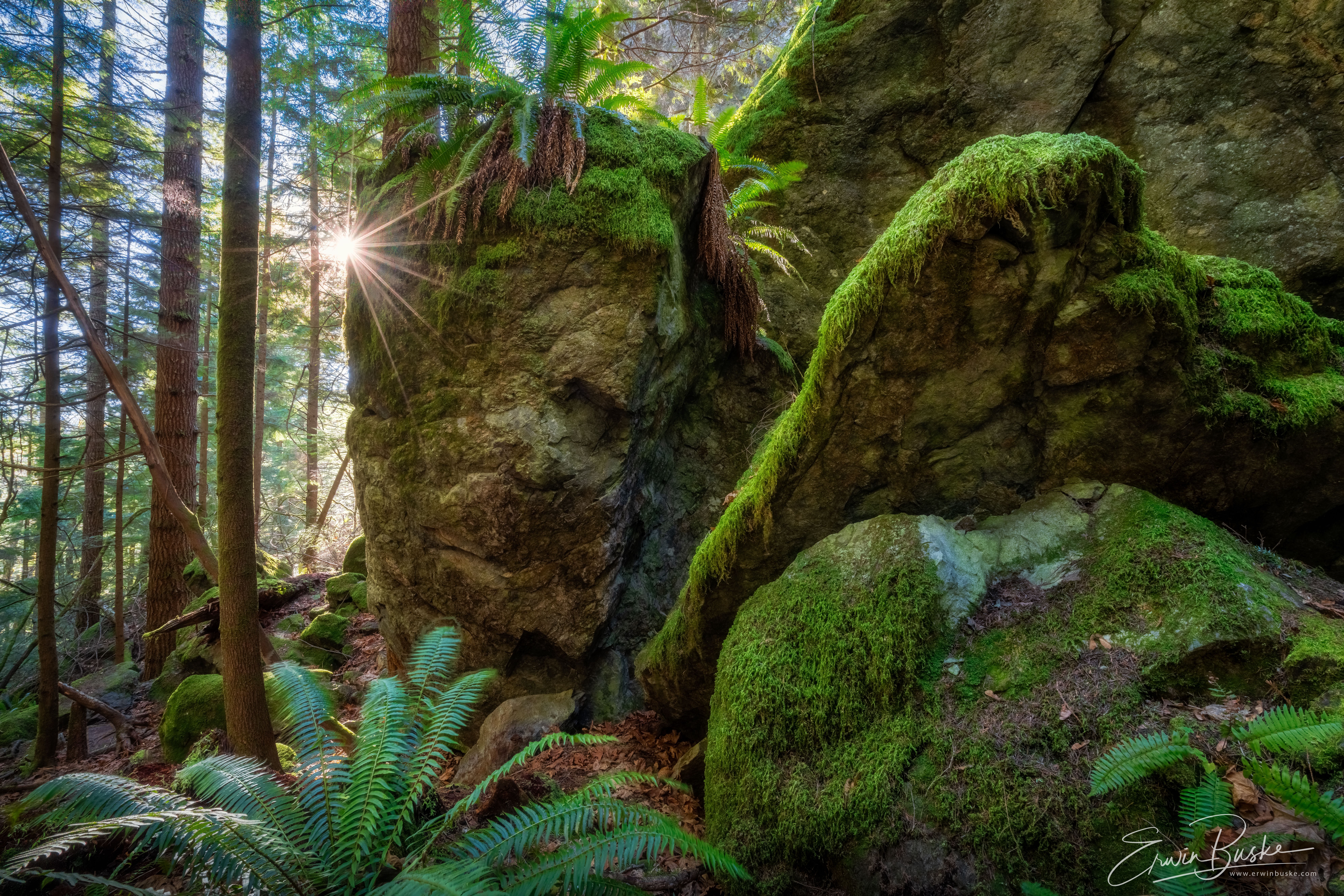
Boulder Garden–This image was taken below Little Si, not exactly an iconic spot, and often quickly passed over on the way to the small peak. But on this day I followed a still small voice of nature that said this is the spot for meditation (and photography!) today.
Are you currently living the life you imagined for yourself? Are there steps you can take, some small and some large, that can lead you to a life more consistent with your calling? For photographers, are the images you are sharing on social media those which express your own voice and calling rather than conforming to some standard, not your own, that is associated with achieving recognition or popularity at little or no risk?
(6) Solitude
“As you simplify your life, the laws of the universe will be simpler; solitude will not be solitude, poverty will not be poverty, nor weakness weakness.” Walden Conclusion
I never found a companion that was so companionable as solitude. Walden Chapter Five Solitude

Lone Trillium in the Forest
Walking around Walden Pond, Thoreau experiences solitude in nature, but in this solitude he is not lonely, because he is part and partial of nature. In his participation in nature Thoreau finds freedom: freedom from a societies institutions, competitive pressures, and petty gossip.. Nature prevents him from ever really being alone. In the company of animals, plants, and the elements, Thoreau finds an inexhaustible source of spiritual nourishment. Thoreau is careful to differentiate between solitude and loneliness, which one can feel even when one is in the company of other people. For Thoreau in his experience at Walden Pond, it is solitude, not society, which prevents loneliness. Even in solitude, one is connected to the natural world and web of life.
Do you frequently set time in your schedule to be alone with nature? If not, are there some steps you can take to have what Julia Cameroon calls in her landmark book the Artist’s Way, a date with yourself, just you and nature?
(7) Inward Journey
Direct your eye right inward, and you’ll find
A thousand regions in your mind
Yet undiscovered. Travel them, and be
Expert in home-cosmography. Thoreau Walden Conclusion
In this passage where Thoreau is reflecting upon his experience at Walden’s Pond, he exhorts us to take the inward journey because this is where the true frontier of self discovery lies. To find this final frontier, Thoreau reminds us there is no compelling reason to travel far and wide to disparate locations around the world. The frontier lies at the intersection of nature and one’s own consciousness where ever one may be, even at Walden Pond, less than two miles from his previous home in Concord, Massachusetts. There is no better way to get to know oneself than through the natural world. But it would be mistake to think one must first travel to a distant place or even a very particular place before taking the inward journey. The right place and time to start the inward journey is close to where you are in the here and now. In every part of nature we can sense the interconnectedness of all of nature, and every part of nature, however, small and humble, can lead us closer to the heart and soul of nature, both within us and without us. We too are nature. For more on the inward journey see Finding your Photographic Vision and the Search for the Authentic Self
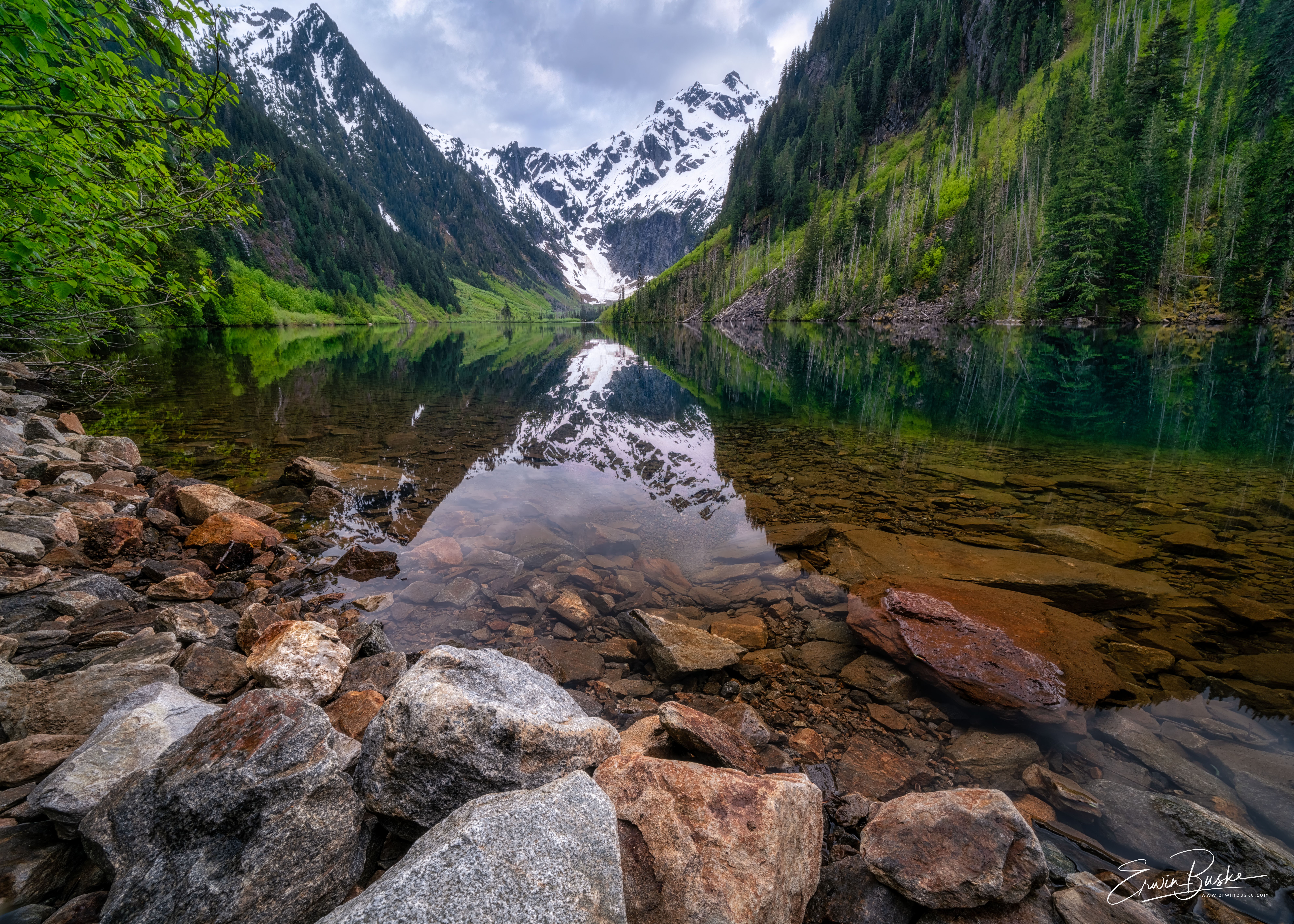
Inner Reflections–Henry M Jackson Wilderness Area
How much to we really know about who we are as a person, our authentic self? What does it mean to you to direct ones eye inward and how might living a life close to nature help this process? For photographers, have you ever noticed that one of your images images of nature reflects both your inner and outer world?
(8) Be Here Now
“You must live in the present, launch yourself on every wave, find your eternity in each moment. Fools stand on their island of opportunities and look toward another land. There is no other land; there is no other life but this.” . Thoreau’s Journal Entry, April 24, 1859
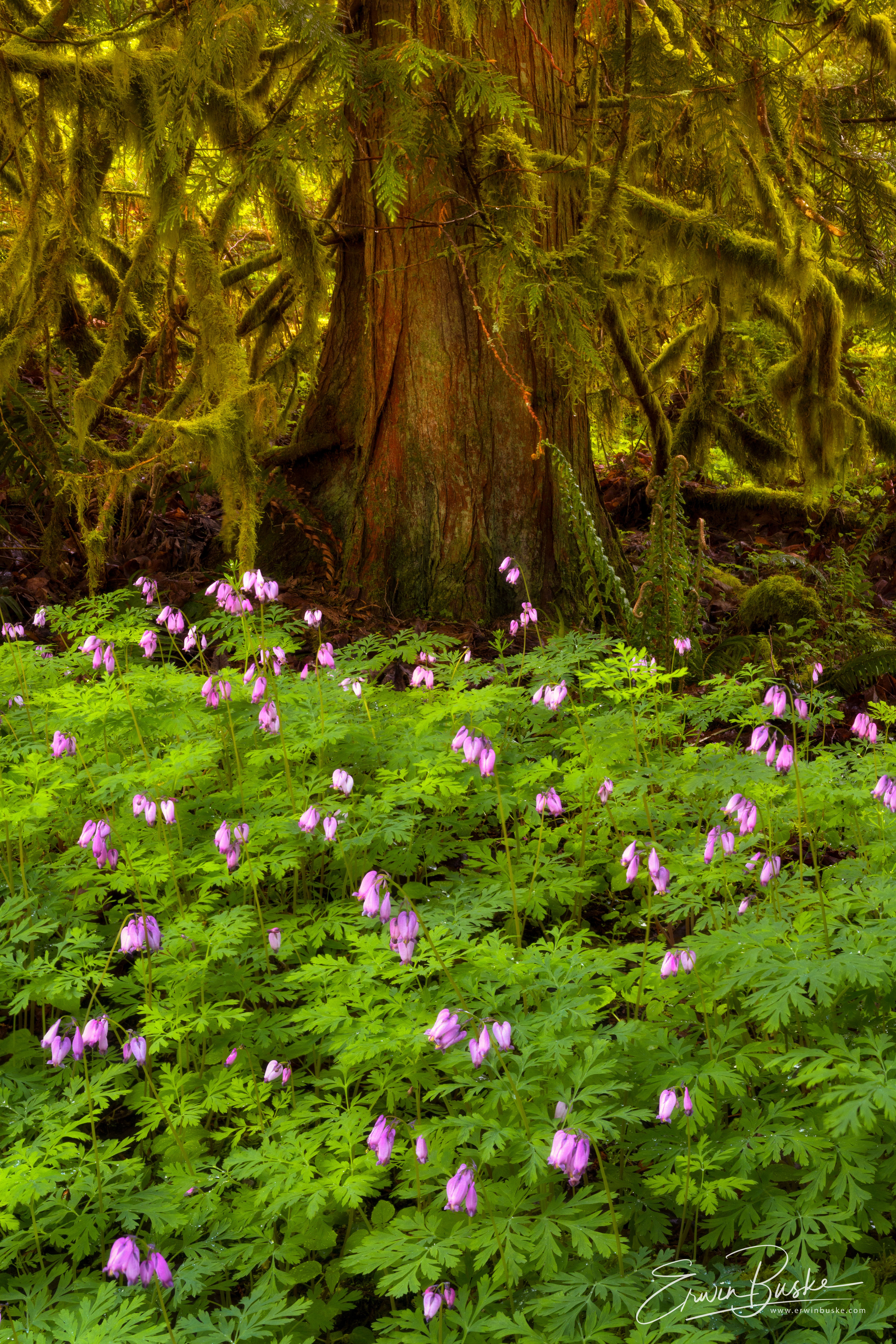
Bleeding Hearts of the Forest–I found this scene on one of my countless walks through a forest close to my home in a suburb of the greater Seattle area. We need not travel far to find nature is one of Thoreau ‘s primary messages.
I believe there is no doubt that Thoreau intended Walden as a kind of spiritual guide for finding fulfillment in ordinary places, even one’s own backyard. It is not just a coincidence that Walden’s pond was only a few miles from the Emerson home in Concord Massachusetts, and in the conclusion of Walden Thoreau specifically states one need not travel far and wide to find fulfillment. It is a kind of irony that eternity can only be experienced one moment at a time, but deep down inside I think we all know it cannot be any other way. All of us must work with the life we have and stop trying to be something we are not. Even in quite modest places and facing only the essential facts of life, great things are still possible for each of us and that is a key message of Walden Pond.
Living in the here and now at Walden Pond came easily to Thoreau, and his daily observation of nature using all five of his senses and documenting this experience helped establish the awareness that made this possible. Granted Thoreau’s senses were far more keenly developed than my own and most people reading this article, but living in the here and now is also possible for each of us if we focus on cultivating awareness through a daily practice of spending quality time in nature.
Examine your own life and your typical daily schedule and ask yourself if you can find a regular time in each day to be a witness to the wonders and beautifies of the natural world. For photographers, how might cultivating a greater awareness of nature on a daily basis, employing all five of your senses, help you in continuing to develop the art and craft of photography?
(9) Waking Up
“We must learn to reawaken and keep ourselves awake, not by mechanical aids, but by an infinite expectation of the dawn, which does not forsake us in our soundest sleep. I know of no more encouraging fact than the unquestionable ability of man to elevate his life by a conscious endeavor. It is something to be able to paint a particular picture, or to carve a statue, and so make a few objects beautiful; but it is far more glorious to carve and paint the very atmosphere and medium through we which we look, which morally we can do. To affect the quality of the day, that is the highest of arts. Every man is tasked to make his life, even in its details, worthy of the contemplation of his most elevated and critical hour.” Walden Chapter -Where I lived and What I Lived For.
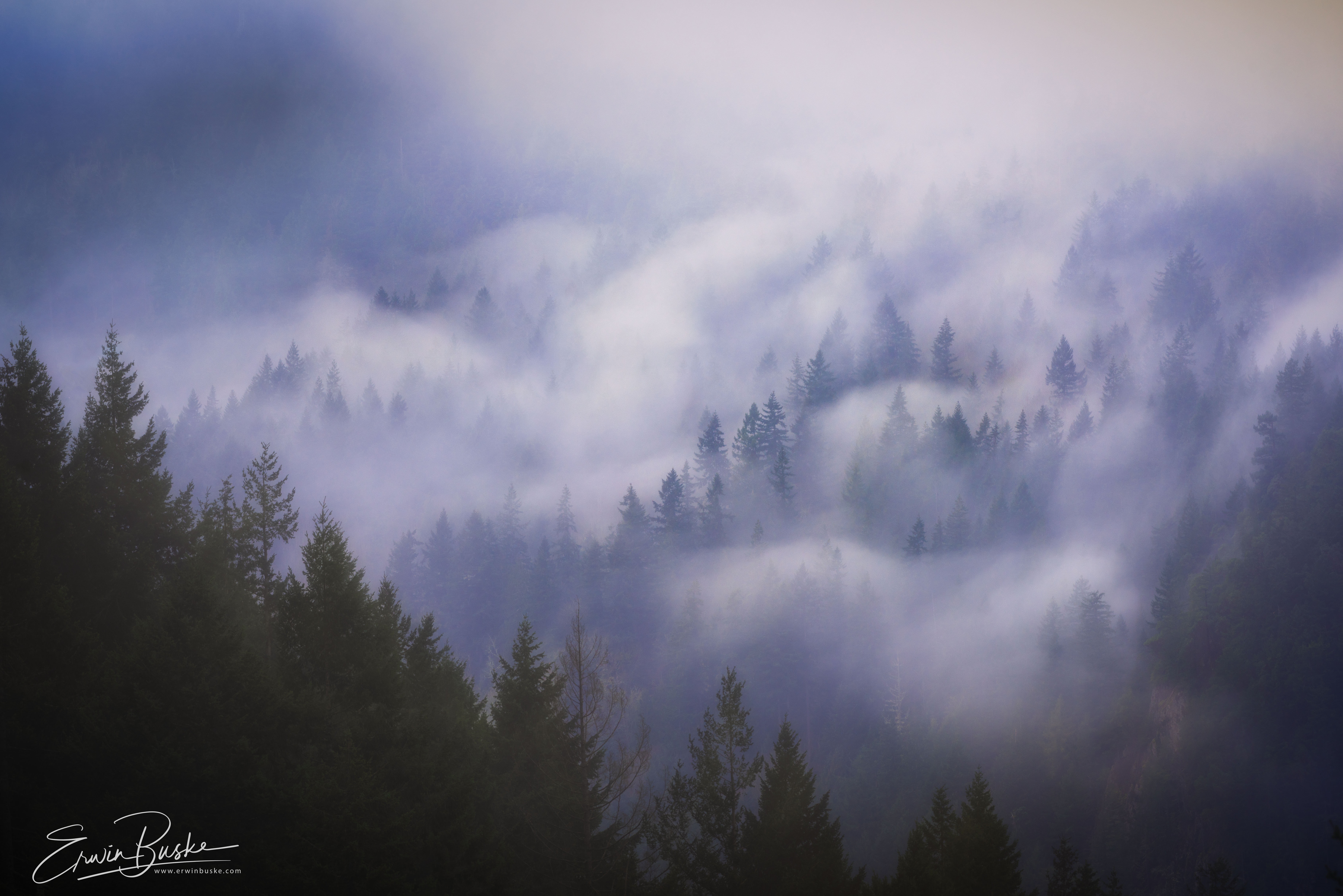
Dawn of a New Day
For Thoreau the “infinite expectation of the dawn” is a metaphor for spiritual awakening, moving out of our often unconscious lives and living life in a much more conscious manner. In Walden Thoreau states “to be awake is to be alive”. Thoreau thought most of us live lives of quiet desperation, being in a kind of semi conscious slumber, or in the words of Pink Floyd’s lyricist “comfortably numb’. The script for our lives, however, is often not our own, but comes from a society that places more priority on material gain, status and popularity than spiritual development. In this passage Thoreau reminds us there is another way and sounds a joyful and positive note. Through living close to nature, simplifying, and living a more conscious life, we have the opportunity to create and shape our own destinies. Here Thoreau uses the examples of a sculptor or painter who are just replicating in their art the beauty that they see around them and comparing this to the sculpture or painter who carves and paints the very atmosphere and medium through which they look. The later is not just documenting the world that they see around them but through their conscious actions as self aware individuals are creating something new. The artist does not need to conform to the world that surrounds them. The artist instead can become the center of his or her world and actually help shape this world making it a better place “worthy of contemplation”.
What does it mean to you “to elevate ones life through a conscious endeavor’? Is there a relationship between our conscious awareness of each moment, where we focus our attention, and our own potential for growth? For photographers what does it mean to you “to paint (photograph) the very atmosphere and medium through which you look” rather than just to paint (photograph) a few beautiful objects? Is Thoreau talking about the process of artistic creation rather than just documenting a scene?
(10) Follow Your Dreams “If one advances confidently in the direction of his dreams, and endeavors to live the life which he has imagined, he will meet with a success unexpected in common hours”. He will put some things behind, will pass an invisible boundary; new, universal, and more liberal laws will begin to establish themselves around and within him; or the old laws will be expanded, and interpreted in his favor in a more liberal sense, and he will live with the license of a higher order of beings. In proportion as he simplifies his life, the laws of the universe will appear less complex, and solitude will not be solitude, nor poverty poverty, nor weakness weakness. ” Thoreau Walden Conclusion
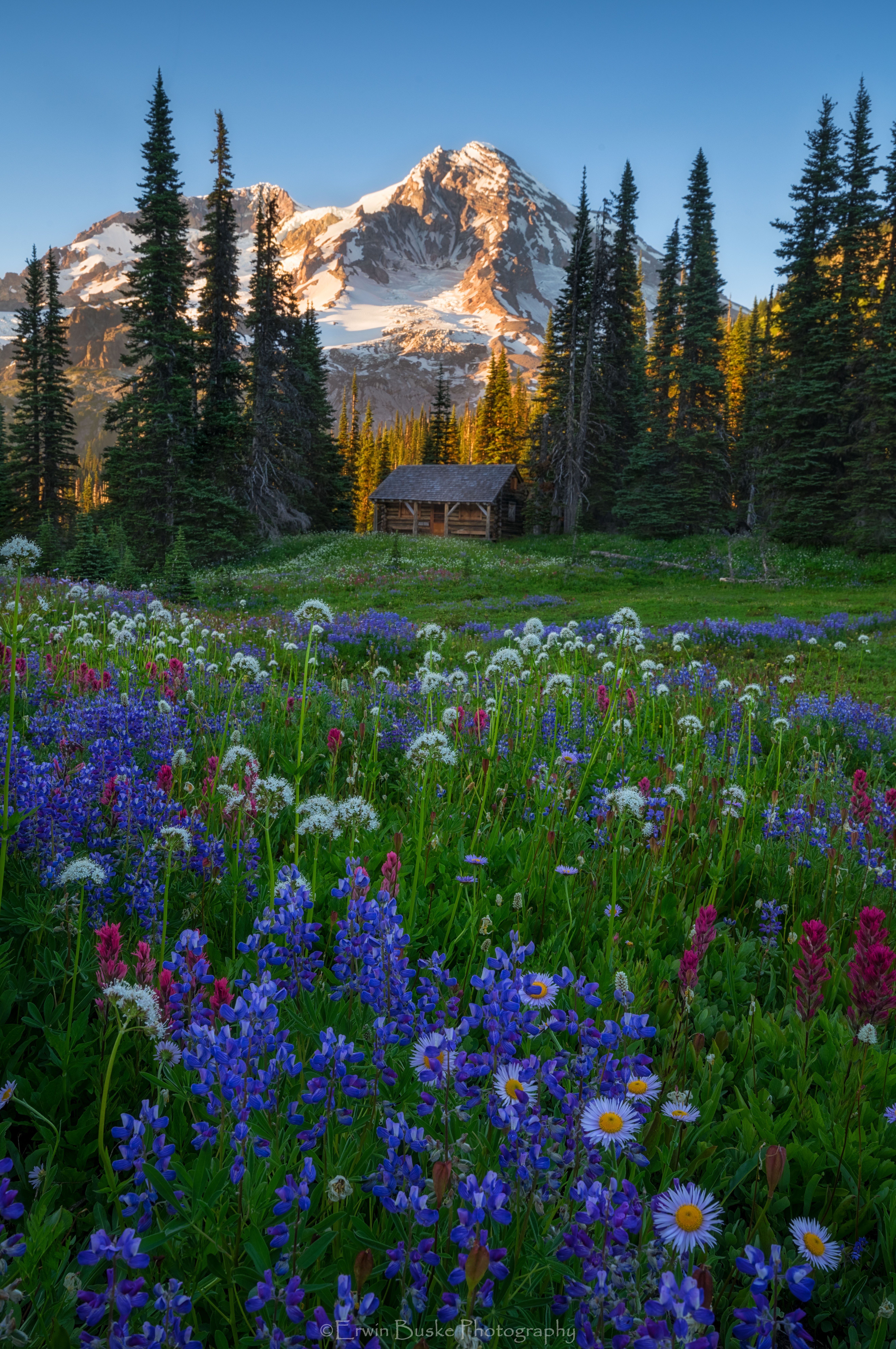
Walking Into a Dream, Mt. Rainier
Once one has embarked on a path of voluntary simplicity, living close to nature and one begins to wake up and discover his/her authentic self and divine nature– it is time to create a vision to develop ones potential for greatness. By greatness, Thoreau of course is not talking about material success or ego aggrandizement, but developing a larger sense of self, ones true nature, grounded in spiritual awareness. Thoreau knows from his personal experience, and admonishes us, that the important thing is to move forward in the direction of our dreams. This is what Thoreau did with his experiment at Walden Pond and in the years following when he created the book Walden, a Life in the Woods, and this path is available to us as well. Each individual’s journey will of course be different. In finding our vision, however, we should not just settle for the ordinary. The vision needs to be challenging and creative. Once we start to move forward, what at first may have seemed impossible will seem less difficult and step by step our larger sense of self and potential will come into view. It is as if all the universe and all of its laws want us to succeed and we will. Transcendence involves creating a new vision of reality and ones relationship to it. Once one realizes this new vision, there is no turning back. It is as though one has passed an invisible boundary and the only way lies forward.
Looking back at the successes in your life that you feel best about, were these also times where you moved in the direction of your dreams without knowing for sure how all the pieces would come together? For photographers, what are your dreams for the future? Do your creative dreams put nature first ahead of plans for commercial success?
(11) Stay Grounded
“If you have built castles in the air, your work need not be lost; that is where they should be. Now put the foundations under them”. Walden Conclusion
Although Thoreau encourages us to dream big and have lofty goals, he places equal emphasis on staying grounded. In a sense with Walden, Thoreau is ushering in the possibility of change and a new vision with nature at its center to help us reach our highest potential. But this new vision for personal transformation needs a solid foundation.

Beauty at the Forest Floor
Emerson wrote in his essay the Transcendentalist “We have yet no man who has leaned entirely on his character, and eaten angels’ food; who, trusting to his sentiments, found life made of miracles; who, working for universal aims, found himself fed, he knew not how; clothed, sheltered, and weaponed, he knew not how, and yet it was done by his own hands.” Thoreau gave his dream a solid foundation through multiple actions discussed in Walden, not just the building of the foundation for his small cabin in the woods and his work in his garden, but also his daily spiritual practice of contemplation, walking, conversations, writing, and reading. Living our dream will not be a constant experience of divine ecstasy. Beware of false new age prophets who promise this. A good portion of our time will be spent finding a balance of tending to doing what is necessary to secure our basic needs and in our free time tending to our daily spiritual practice. With this foundation work in place, we can direct the remaining energy to pursuing our creative vision.
What activities and pursuits in your life help you to feel grounded? Is it possible to pursue your dreams but at the same time cultivate those activities which keep you grounded?
(12) Rebirth
“I left the woods for as good a reason as I went there. Perhaps it seemed to me that I had several more lives to live, and could not spare any more time for that one”. Thoreau Walden Conclusion
When Thoreau decided to embark upon his experiment in simple living at Walden Pond, he did so in part because he thought that his life had become to routine. Living at Walden Pond taught him many things not the least of which was the rhythm and cycles of nature. Nature is constantly reinventing itself, not only with the changing seasons, but in the longer term with transformations of the landscape itself. After two years at Walden Thoreau once again thought his life had become routine and it was time to redirect his energies.

From Ashes to Eden
In an area that in recent times was ashes and dust following the eruption of Mt. St. Helen’s, we now see beautiful fields of flowers to direct the eye to this still active volcano.
Although Thoreau kept journal entries at Walden Pond, the book itself was not yet written and it would take him another seven years to finish the creative masterpiece that now serves as a modern day myth and guide for achieving personal and spiritual transformation through immersion in nature. Thoreau also firmly believed that personal and spiritual transformation through nature would lead one to a higher moral outlook. Thoreau had much more work to do in gathering and writing his thoughts on the importance of civil disobedience, and his own role in supporting the abolition of slavery. Had Thoreau lived longer we likely would have seen a lot more from this champion of nature. His legacy however is born anew everyday in the lives of millions of people the world over, bringing them closer to nature and its protection, inspiring the quest for spiritual growth, and encouraging people to conduct themselves in a manner that is consistent with their own conscience.
Do you sometimes feel that you have many more lives to live? Do these feelings cause you to make changes in you life to help you to live the life/lives you imagined?
Conclusion
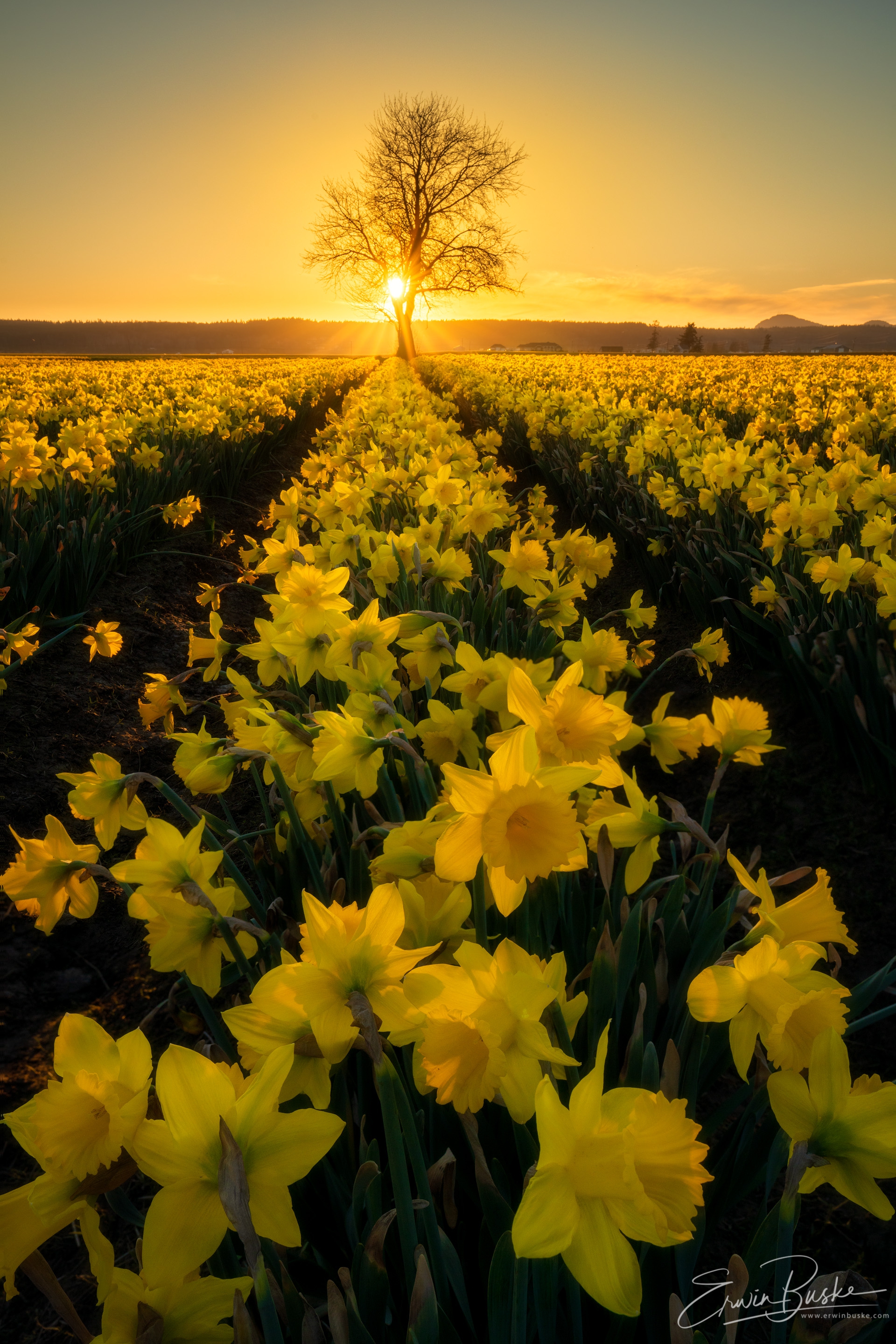
“The light which puts out our eyes is darkness to us. Only that day dawns to which we are awake. There is more day to dawn. The sun is but a morning star. ” Thoreau Walden
Walden or Life in the Woods, is a spiritual guide for the process for each of us to wake up to our own divine nature. Although Walden was a physical place, Thoreau wanted each of us to embark upon a journey to our own Walden Pond. This pond, a symbol for the care of the soul and self realization, can be anywhere and is most likely to physically exist close to where we are in the here and now. Ultimately Walden is beyond the physical realm, and is in the hearts and minds of each of us waiting to be discovered.
Erwin Buske Photography, Copyright 2019
Thanks for reading this blog post. I greatly appreciate this and would love to hear from you. Please leave a comment with your thoughts on this posts. If you would like to receive additional posts like this please also follow this blog either through word press or a request for email notifications. If you feel so inclined please help me reach people who may be interested in this post through sharing. Thanks!
————————————————————————————————————————————
References and Additional Resources:
Walden or Life in the Woods, Henry David Thoreau, 1854
The Journal 1937-1861 Henry David Thoreau, Edited by Damion Searls
Thoreau As Spiritual Guide, Barry M. Andrews, 2000
Henry David Thoreau: A Life, By Laura Dassow Walls, 2017
Emerson, Thoreau, and the Transcendentalists, By Great Courses
The Transcendentalist, Ralph Waldo Emerson, 1842
Nature, Ralph Waldo Emerson, 1836
Transcendental Nature Photography: Creating Images with Lasting Impact, Erwin Buske Photography Blog
Finding Your Photographic Vision and the Search for the Authentic Self, Erwin Buske Photography Blog
Sources of Inspiration for Nature and Landscape Photographers
The Walden Woods Project (founded by Don Henley)
The Perennial Philosophy, Aldous Huxley, 1944
A Passion for Nature: The Life of John Muir, Donald Worster, 2008

I too read and loved Thoreau in high school. Thank you for your insight and a revisit to Thoreau’s words and values. Your images and 12 takeaways are inspirational.
LikeLike
Thanks so much Sheila for your feedback. I am very happy you enjoyed reading about my 12 takeaways!
LikeLike
When I first saw your photography I was mesmerized by the beauty and skill of each shot. It felt as though I was there too. I tell people all the time your my favorite photographer, and the natural beauty you capture is one of the reasons I love living here in the PNW. Then to find out you’re a student of Thoureau is quite interesting. Reading Thoerau in my college Philosophy class literally and figuratively changed my life. I know that sounds totally cliche but it’s true. No wonder your work is so breatakingly inspirational. Great read.
LikeLike
Thanks Jill.! I greatly appreciate your feedback. Thoreau has the ability especially through Walden and his daily journal to touch so many of our lives, often in ways (as is the case with me) in ways we do not fully appreciate until years later. It is wonderful that reading Thoreau in you philosophy class had such a profound impact. I have had a few class that similarly impacted me. I hope schools continue to offer Thoreau in their instruction in both high schools and colleges.
LikeLike
Your photography is outstandingly good, Erwin. Every photo is perfectly composed and the display oaf light and colours are breathtakingly beautiful. Thank you for sharing your insight, the background history and your personal twelve take aways. This is most certainly a blog post that I’ll save to study further. It was a pleasure visiting you, I’m your new follower. 🙂
Warm greetings from North Norfolk,
Dina
LikeLike
Thanks so much Dina for the compliments. I really appreciate the time you took to provide this feedback. The Walden piece has a lot of information and it likely will be worthwhile to give it another read at a future time. My understanding of Thoreau has evolved steadily over the past couple of years and continues to evolve every time a go back and reads his works! Maybe someday I will fully get it, but I doubt it!
LikeLike
Hi Erwin! You make beautiful pictures first of all, i ordered the book for study, thanks for capturing some interesting things from this book. It hits me right in the heart.
LikeLike
Walden is a wonderful book that has much to say about the healing powers of nature and how nature speaks to our soul. Thanks so much!
LikeLike